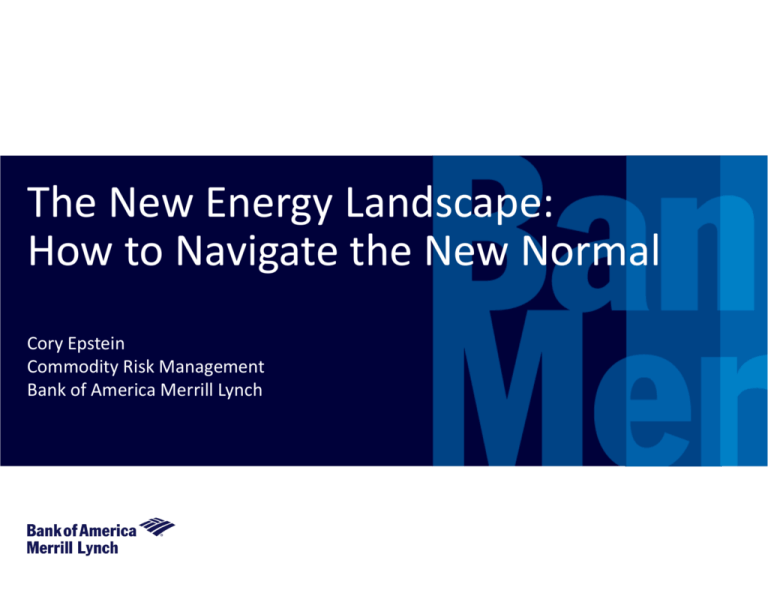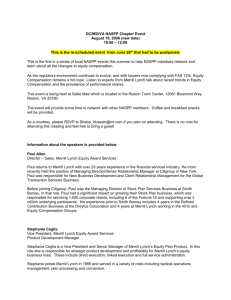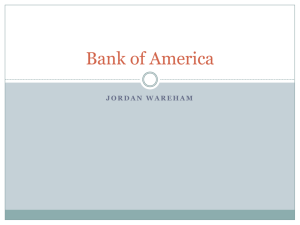
The New Energy Landscape:
How to Navigate the New Normal
Cory Epstein
Commodity Risk Management
Bank of America Merrill Lynch
Notice to Recipient
Confidential
"Bank of America Merrill Lynch" is the marketing name for the global banking and global markets businesses of Bank of America Corporation. Lending, derivatives, and other commercial banking activities
are performed globally by banking affiliates of Bank of America Corporation, including Bank of America, N.A., member FDIC. Securities, strategic advisory, and other investment banking activities are
performed globally by investment banking affiliates of Bank of America Corporation ("Investment Banking Affiliates"), including, in the United States, Merrill Lynch, Pierce, Fenner and Smith Incorporated is a
registered broker dealer and member of FINRA and SIPC, and, in other jurisdictions, locally registered entities.
Investment, annuity and insurance products: Are Not FDIC Insured, May Lose Value, Are Not Bank Guaranteed, Are Not Insured by Any Federal Government Agency, Are Not Deposits, Are Not
a Condition to Any Banking Service or Activity
This material is NOT a research report under U.S. law, NOT a research department product and is intended only for sophisticated investors/clients. It has been prepared by, and is a product of, a desk that
supports out as impartial in relation to such activities.
These materials have been prepared by one or more subsidiaries of Bank of America Corporation for the client or potential client to whom such materials are directly addressed and delivered (the
“Company”) in connection with an actual or potential mandate or engagement and may not be used or relied upon for any purpose other than as specifically contemplated by a written agreement with us.
These materials are based on information provided by or on behalf of the Company and/or other potential transaction participants, from public sources or otherwise reviewed by us. We assume no
responsibility for independent investigation or verification of such information (including, without limitation, data from third party suppliers) and have relied on such information being complete and accurate in
all material respects.
The estimated values provided in the material are "as of" the date indicated and do not represent actual bids or offers by ML. Even though the material is based upon publicly available information and news
sources that are generally believed to be reliable, there can be no assurance that actual trades could be completed at such value(s). Because these estimated valuations are based on underlying valuations
obtained from third party sources we cannot make any representation as to the accuracy or completeness of the valuations. The material is not intended to be a comprehensive summary of all material
news, information, events and risks relating to the companies or securities mentioned. ML does not make any representation or warranty as to the accuracy or completeness of this material, and, by
accepting the material, you agree that ML shall not be responsible for any error or omission. References to past prices or quotes do not in any way imply that such prices or quotes will again be available or
actionable. These estimates may not be representative of any theoretical or actual internal valuations employed by us for our own purposes, may vary during the course of any particular day and may vary
significantly from the estimates or quotations that would be given by another dealer.
This material does not constitute an offer, or a solicitation of an offer, to purchase or sell any security or financial instrument, nor does the material constitute advice or an expression of ML's view as to
whether a particular security or financial instrument is appropriate for you and meets your financial objectives. ML will not be liable for any investment decision based in whole or in part on the material. The
reader is required to make its own investment decisions, using as necessary the advice of independent advisors or consultants. As a condition for providing these estimates, you agree that Merrill Lynch
makes no representation and shall have no liability in any way arising there from to you or any other entity for any loss or damage, direct or indirect, arising from the use of this information. ML and its
affiliates may trade for their own accounts as market maker, block positioner, dealer, specialist, arbitrageur or speculator in any of the securities of issuers mentioned in this material. When trading for
proprietary accounts, ML and its affiliates may consider the material in their trading decisions, as appropriate. Principal transactions by ML and its affiliates are effected in accordance with applicable rules
and regulations, and such transactions may affect the prices of the securities mentioned. Further, ML and its affiliates may from time-to-time perform investment banking or other services for, or solicit
investment banking or other business from, any company mentioned in the material. This material may not be distributed outside the United States; and is intended solely for Global Markets institutional
clients. The material is provided for informational purposes only and any distribution or copying of the material is prohibited.
We do not provide legal, compliance, tax or accounting advice. Accordingly, any statements contained herein as to tax matters were neither written nor intended by us to be used and cannot be used by
any taxpayer for the purpose of avoiding tax penalties that may be imposed on such taxpayer. If any person uses or refers to any such tax statement in promoting, marketing or recommending a partnership
or other entity, investment plan or arrangement to any taxpayer, then the statement expressed herein is being delivered to support the promotion or marketing of the transaction or matter addressed and the
recipient should seek advice based on its particular circumstances from an independent tax advisor. Notwithstanding anything that may appear herein or in other materials to the contrary, the Company
shall be permitted to disclose the tax treatment and tax structure of a transaction (including any materials, opinions or analyses relating to such tax treatment or tax structure, but without disclosure of
identifying information or, except to the extent relating to such tax structure or tax treatment, any nonpublic commercial or financial information) on and after the earliest to occur of the date of (i) public
announcement of discussions relating to such transaction, (ii) public announcement of such transaction or (iii) execution of a definitive agreement (with or without conditions) to enter into such transaction;
provided, however, that if such transaction is not consummated for any reason, the provisions of this sentence shall cease to apply.
Bank of America Corporation and its affiliates (collectively, the "BAC Group") comprise a full service securities firm and commercial bank engaged in securities, commodities and derivatives trading, foreign
exchange and other brokerage activities, and principal investing as well as providing investment, corporate and private banking, asset and investment management, financing and strategic advisory services
and other commercial services and products to a wide range of corporations, governments and individuals, domestically and offshore, from which conflicting interests or duties, or a perception thereof, may
arise. In the ordinary course of these activities, parts of the BAC Group at any time may invest on a principal basis or manage funds that invest, make or hold long or short positions, finance positions or
trade or otherwise effect transactions, for their own accounts or the accounts of customers, in debt, equity or other securities or financial instruments (including derivatives, bank loans or other obligations) of
the Company, potential counterparties or any other company that may be involved in a transaction. Products and services that may be referenced in the accompanying materials may be provided through
one or more affiliates of Bank of America Corporation. We have adopted policies and guidelines designed to preserve the independence of our research analysts. These policies prohibit employees from
offering research coverage, a favorable research rating or a specific price target or offering to change a research rating or price target as consideration for or an inducement to obtain business or other
compensation. We are required to obtain, verify and record certain information that identifies the Company, which information includes the name and address of the Company and other information that will
allow us to identify the Company in accordance, as applicable, with the USA Patriot Act (Title III of Pub. L. 107-56 (signed into law October 26, 2001)) and such other laws, rules and regulations as
applicable within and outside the United States.
©2015 Bank of America Corporation. All rights reserved.
Bank of America Merrill Lynch Commodities
Table of Contents
1) Introduction
2) The New Energy Landscape
Crude Oil
US Natural Gas
3) How To Navigate the New Normal
The Case for Hedging Natural Gas
Hedging Strategy
4) Appendix
Bank of America Merrill Lynch Commodities
Introduction
Commodities prices, more than any other product class, have experienced material volatility over the last
several years. The graph below illustrates relative price performance since Jan09. Notice how 3M LIBOR,
DJIA, and the Dollar Index (DXY) have been relatively stable compared to a sampling of commodities prices.
Not only have absolute commodities price levels risen, but volatility has as well.
Volatility across crude oil and natural gas is creating new winners and losers across industries, and even
within certain sectors of the economy.
How are oil and gas producers responding to
the new price environment?
What are oil and gas consumers doing to take
advantage of the new price environment?
While the new energy environment has
created financial losses and other issues for
many companies, it has also created unique
opportunities for those that can understand,
weather, and anticipate the new normal.
350%
Relative Price Performance Since Jan09
300%
250%
200%
150%
100%
50%
0%
-50%
-100%
DJIA
Source: Merrill Lynch Commodities, Inc. Proprietary.
LIBOR
DXY
Cotton
Copper
WTI
Nat Gas
The New Energy Landscape:
Crude Oil
The New Energy Landscape
Crude Oil – How Did We Get Here?
Oil markets have seen a precipitous decline over the past
few months as global supply has surged on US shale
production and the return of Libyan exports while demand
has waned and perceived geopolitical threats have not
materialized. The biggest declines came after the OPEC
meeting in late November in which the cartel decided not
to cut production as it has done historically in times of
oversupply as individual members fight for market share.
WTI Historical Prices
$140
$120
$100
$80
$60
The staggering crude oil inventory build in the US – 109
million bbl over 18 weeks – has finally started to slow
down as demand from refiners has picked up seasonally.
Global inventories are still building, but the rate of builds
has started to soften. This factor, combined with
expectations of tighter global oil balances in the longterm, has led to a rally in global crude oil prices since midMarch.
Weekly rig count statistics, reported by Baker Hughes is
perhaps the single most important lead indicator of where
US oil output goes next. This count has decreased by over
806 since December, a dramatic decline. However,
production is still growing and wells are becoming more
efficient.
1
Source: Merrill Lynch Commodities, Inc. Proprietary (upper), Bank of America Merrill Lynch Research (lower).
$40
Historical Price
Mean - 1 St.Dev
Mean
Mean +1 St.Dev
The New Energy Landscape
Crude Oil – What Can We Expect Going Forward?
The run-up in prices conceals a stubbornly weak
underlying fundamental balance – Initially, the oil market
surplus was reflected in large increases in crude
inventories, placing downward pressure on crude oil
prices. Now, we can expect to see petroleum products
building as refineries ramp up after maintenance.
Due to continuing weakness in the fundamental balance,
the BAML Research team sees potential for a double-dip in
prices by the end of 3Q15. The Research team anticipates
a dip in WTI to $50/bbl as refinery maintenance kicks in
again in September before recovering to $57/bbl by yearend.
We see WTI prices for 2016 capped on increased hedging
activity in North America and maintain our 2016 WTI
crude oil price forecast of $57.
Many large E&Ps have mentioned delaying rig completions
as the strong contango incentives delays, especially with
cost declines coming in / expected from service areas as
many contracts expire and producers move to spot pricing
(materially lower). With shale value being predominantly
skewed to the first few years of production, management
teams are acknowledging the benefit of deferring wells.
WTI Forward Curves
$100
$90
$80
$70
$60
$50
$40
9 mo ago
2
Source: Bank of America Merrill Lynch Research (upper), Merrill Lynch Commodities, Inc. Proprietary (lower).
6 mo ago
3 mo ago
Recent
The New Energy Landscape:
US Natural Gas
The New Energy Landscape
Natural Gas – How Did We Get Here?
The US natural gas market has had a phenomenal
turnaround over the past year. In the winter of 2014, a
polar vortex created a yawning inventory gap which
boosted prices above $6/MMBtu. This winter has seen an
inventory glut which has pushed prices below
$2.50/MMBtu.
Prices are now at levels last seen in 2012 and could see
further weakness going into the summer given high
output, particularly in the Northeast. BAML Research has a
2015 average forecast of $2.85/MMBtu.
However, the longer term outlook for US natural gas
production is decidedly negative. Associated gas supply in
places like the Eagle Ford is expected to fall as producers
cut capex. Northeast production will decline into year end
in response to the 50% drop in NGL prices. By the end of
2015, the combination falling production and strong
demand growth will likely eliminate the slack in gas
balances. This rebalancing could set the market up for a
meaningful price recovery and we expect prices to average
$3.90/MMBtu in 2016.
3
Source: Merrill Lynch Commodities, Inc. Proprietary (upper), Energy Information Administration (lower).
NYMEX Natural Gas Historical Prices
The New Energy Landscape
Natural Gas – What Can We Expect Going Forward?
(2008-2012) Supply driven bear market
Large shifts in natural gas supply curve driven by new shale gas supplies
Limited structural demand growth
Production growth (~2.4 BCF/D per annum) much greater than structural demand growth (~0.5 BCF/D p.a.)
Increasing amounts of price-induced fuel switching and declining imports needed to balance the market
(2013-2014) Balanced S&D (Range bound, with volatility)
YOY supply growth ramps in 2014 with infrastructure build-out and increasing drilling efficiencies
Structural demand growth emerges; decreasing amounts of price-induced fuel switching needed to balance the
market
Power burn becomes increasingly elastic in reaction to near term forwards and cash price fluctuations; this is a
temporary phenomenon as incremental coal retirements will reduce switching flexibility
Short-term, demand induced price spike seen Winter 2013-2014; 30 year winter created large storage hole
placing floor under summer 2014 prices; reveals inelasticity of demand during extreme weather periods
(2015-2018) Rapid Structural Demand Growth
Unprecedented structural demand growth driven by:
4
New industrial demand (2-3 BCF/D)
Coal plant retirements and conversions to natural gas (2-6 BCF/D)
Transportation fuel demand (1 BCF/D)
LNG exports (2-6 BCF/D)
Pipeline exports to Mexico (3-5 BCF/D)
Based on current drilling economics, supply should be able to keep pace with demand during this time period at
prices similar to forward curve. However, as winter 13-14 revealed, any increase in inelastic demand decreases
switching ability and creates for higher volatility and price level
The New Energy Landscape
Natural Gas – Increased Demand Drives Higher Prices
Huge growth in production has not led to huge growth in
inventories.
LNG export capacity will increase dramatically in coming
years.
$100+ billion of capital investment in gas-burning facilities
have been announced.
We expect industrial demand to increase by ~0.5
Bcfd per year for at least the next five years as these
projects are completed.
New infrastructure and increased Mexican gas demand
will increase exports to Mexico
Coal retirements will create incremental demand for
natural gas and reduce elasticity of demand
Electric generation coal capacity has been reduced
in recent years and this trend is expected to
continue over the next few years. Relatively low
natural gas prices and EPA rules such as Mercury
and Air Toxics Standards (MATS) are spurring coal
plant retirements.
Coal to gas switching Has helped balance the
natural gas market in recent years But going
forward, coal retirements will likely reduce the
market’s ability to balance supply and demand.
5
Source: Energy Information Administration (upper and lower).
The New Energy Landscape
Natural Gas – Wind Generation Hedges Have Flattened the Curve
Due to positive economics for new wind generation, supported by the Production Tax Credit
(“PTC”) which expired at the end
of 2014, Texas has experienced a large number of filings for development of new wind farms.
Due to a lack of liquidity in the back of the power curve, BofAML believes that many of the buyers of wind generation are
hedging via gas sales to offset a portion of the risk for their purchased power. This has resulted in pressure on the back of the
gas curve, significantly flattening the curve over the past 2 years.
A typical wind hedge spans ~10 to ~12 years , beginning in 2015-2017 and represents ~35% of the nameplate capacity.
Once this hedging pressure is removed, demand side fundamentals should bid the curve in order to elicit a production
response.
6
Source: Bloomberg.
How to Navigate the New Normal:
The Case for Hedging Natural Gas
How to Navigate the New Normal
The Case for Hedging Natural Gas
The volatility in prices has been staggering. Individual
price spikes can be severe, and financial risk management
provides a means of insulating your business from this sort
of volatility.
The current environment is very compelling for natural gas
consumers. Many clients are initiating hedging programs
with their first ever trades or adding layers to existing
hedge portfolios. We are also seeing interest in longdated hedges from our clients who consume material
amounts of gas. This activity isn’t confined to just a single
sector. Utilities, municipalities, energy distributers,
chemical companies, fertilizer manufacturers, ethanol
producers, and others who know natural gas very well are
seeing value in the current pricing.
So, why look at hedging gas now?
Aren’t we the “Saudi
Arabia” of gas with all of our shale production? Yes, our
production has definitely ramped up. In fact, between
2008 and 2012, production grew about 2.5 bcf/day per
annum while demand only grew about 0.5. This is one
reason why prices fell so much; natural gas companies’
exploration and drilling programs outpaced a sluggish US
economy. However, we are finding at least as many new
ways to consume natural gas as we are to produce it. Also,
last winter, the coldest in 30 years, reminded us that no
matter how much gas we produce, we can only store so
much. The fact is that demand growth, combined with
LNG export potential, is catching up with supply.
7
Source: Merrill Lynch Commodities, Inc. Proprietary (upper), Bank of America Merrill Lynch Research (lower).
NYMEX Natural Gas Historical Prices
How to Navigate the New Normal:
Hedging Strategy
How to Navigate the New Normal
Hedging Strategy – Winning or Losing?
If you are looking at hedging as winning or losing, you are missing the point.
Hedges are not bets. They are
valuable budgeting and forecasting tools. A hedge defines a price, lending certainty where there is none.
Assume you hedge 50% of your consumption at $3.00
If the floating price rises to $6.00, you are happy that your hedge is in the money and will gain you
$3.00
that month. Your average cost is $4.50.
If the price falls to $0.00, you are upset that your hedge is out of the money and will cost you $3.00 that
month. Your average cost is $1.50.
The point to take away from this is that, whatever happens in the market, you have hedged 50% of your
consumption at $3.00.
8
How to Navigate the New Normal
Hedging Strategy – How Much Do You Hedge?
In considering how much to hedge, many begin at 50% fixed /50% floating and adjust up or down according to
additional risks or risk mitigants they find in their business.
Leverage – Higher leverage implies greater sensitivity to costs and less margin for error.
Ability to pass on prices – The less you can pass prices fluctuations through, the more you need risk
management.
Budget performance – Past budget surprises may make protection against similar occurrences more
important.
Margins – Thin margins mean less room for price movement.
Price Outlook – What is your outlook for prices? Are you appropriately positioned?
?
100%
Floating
Price
9
RISK CONTINUUM
100%
Fixed
Price
Appendix
Merrill Lynch Commodities, Inc.
BAML Research Forecasts
Forecasts as of May 28, 2015
10
Source: Bank of America Merrill Lynch Research.
Bank of America Merrill Lynch Commodities
Keeping Our Clients Informed
Solid foundation backed by our experienced commodity research
team led by Francisco Blanch
Research Report Offerings
- Commodity/Energy Strategist – Quarterly comprehensive view of
driving forces in the market
- Global Energy Weekly – Covers the most up-to-date factors in the
energy markets
- Global Commodity Paper – Strategic view on commodities as an
asset class and their interaction with traditional asset classes,
such as equities and bonds
- Physical Metal Exchange – Comprehensive view of fundamental
details on the base and precious metals
- Metals Update – Views and analysis on short-term issues
effecting the markets
Our clients can count on insightful and timely analysis. We are their eyes and ears in the market
so that they can devote research time to other pursuits. We keep them updated daily and
weekly as well as when critical events occur
11





